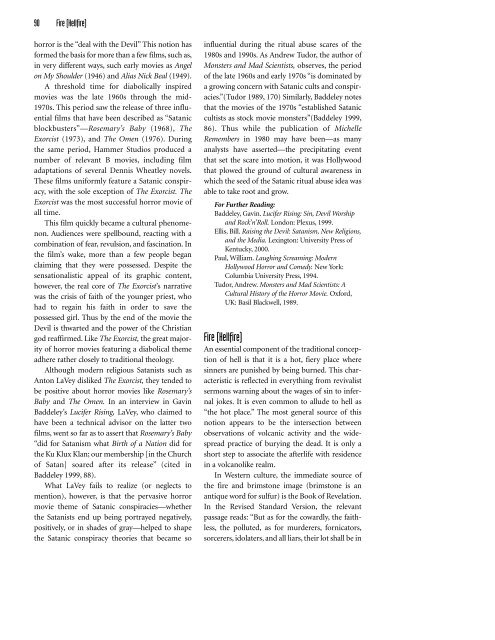Satanism Today - An Encyclopedia of Religion, Folklore and Popular ...
Satanism Today - An Encyclopedia of Religion, Folklore and Popular ...
Satanism Today - An Encyclopedia of Religion, Folklore and Popular ...
Create successful ePaper yourself
Turn your PDF publications into a flip-book with our unique Google optimized e-Paper software.
90 Fire (Hellfire)<br />
horror is the “deal with the Devil” This notion has<br />
formed the basis for more than a few films, such as,<br />
in very different ways, such early movies as <strong>An</strong>gel<br />
on My Shoulder (1946) <strong>and</strong> Alias Nick Beal (1949).<br />
A threshold time for diabolically inspired<br />
movies was the late 1960s through the mid-<br />
1970s. This period saw the release <strong>of</strong> three influential<br />
films that have been described as “Satanic<br />
blockbusters”—Rosemary’s Baby (1968), The<br />
Exorcist (1973), <strong>and</strong> The Omen (1976). During<br />
the same period, Hammer Studios produced a<br />
number <strong>of</strong> relevant B movies, including film<br />
adaptations <strong>of</strong> several Dennis Wheatley novels.<br />
These films uniformly feature a Satanic conspiracy,<br />
with the sole exception <strong>of</strong> The Exorcist. The<br />
Exorcist was the most successful horror movie <strong>of</strong><br />
all time.<br />
This film quickly became a cultural phenomenon.<br />
Audiences were spellbound, reacting with a<br />
combination <strong>of</strong> fear, revulsion, <strong>and</strong> fascination. In<br />
the film’s wake, more than a few people began<br />
claiming that they were possessed. Despite the<br />
sensationalistic appeal <strong>of</strong> its graphic content,<br />
however, the real core <strong>of</strong> The Exorcist’s narrative<br />
was the crisis <strong>of</strong> faith <strong>of</strong> the younger priest, who<br />
had to regain his faith in order to save the<br />
possessed girl. Thus by the end <strong>of</strong> the movie the<br />
Devil is thwarted <strong>and</strong> the power <strong>of</strong> the Christian<br />
god reaffirmed. Like The Exorcist, the great majority<br />
<strong>of</strong> horror movies featuring a diabolical theme<br />
adhere rather closely to traditional theology.<br />
Although modern religious Satanists such as<br />
<strong>An</strong>ton LaVey disliked The Exorcist, they tended to<br />
be positive about horror movies like Rosemary’s<br />
Baby <strong>and</strong> The Omen. In an interview in Gavin<br />
Baddeley’s Lucifer Rising, LaVey, who claimed to<br />
have been a technical advisor on the latter two<br />
films, went so far as to assert that Rosemary’s Baby<br />
“did for <strong>Satanism</strong> what Birth <strong>of</strong> a Nation did for<br />
the Ku Klux Klan; our membership [in the Church<br />
<strong>of</strong> Satan] soared after its release” (cited in<br />
Baddeley 1999, 88).<br />
What LaVey fails to realize (or neglects to<br />
mention), however, is that the pervasive horror<br />
movie theme <strong>of</strong> Satanic conspiracies—whether<br />
the Satanists end up being portrayed negatively,<br />
positively, or in shades <strong>of</strong> gray—helped to shape<br />
the Satanic conspiracy theories that became so<br />
influential during the ritual abuse scares <strong>of</strong> the<br />
1980s <strong>and</strong> 1990s. As <strong>An</strong>drew Tudor, the author <strong>of</strong><br />
Monsters <strong>and</strong> Mad Scientists, observes, the period<br />
<strong>of</strong> the late 1960s <strong>and</strong> early 1970s “is dominated by<br />
a growing concern with Satanic cults <strong>and</strong> conspiracies.”(Tudor<br />
1989, 170) Similarly, Baddeley notes<br />
that the movies <strong>of</strong> the 1970s “established Satanic<br />
cultists as stock movie monsters”(Baddeley 1999,<br />
86). Thus while the publication <strong>of</strong> Michelle<br />
Remembers in 1980 may have been—as many<br />
analysts have asserted—the precipitating event<br />
that set the scare into motion, it was Hollywood<br />
that plowed the ground <strong>of</strong> cultural awareness in<br />
which the seed <strong>of</strong> the Satanic ritual abuse idea was<br />
able to take root <strong>and</strong> grow.<br />
For Further Reading:<br />
Baddeley, Gavin. Lucifer Rising: Sin, Devil Worship<br />
<strong>and</strong> Rock’n’Roll. London: Plexus, 1999.<br />
Ellis, Bill. Raising the Devil: <strong>Satanism</strong>, New <strong>Religion</strong>s,<br />
<strong>and</strong> the Media. Lexington: University Press <strong>of</strong><br />
Kentucky, 2000.<br />
Paul, William. Laughing Screaming: Modern<br />
Hollywood Horror <strong>and</strong> Comedy. New York:<br />
Columbia University Press, 1994.<br />
Tudor, <strong>An</strong>drew. Monsters <strong>and</strong> Mad Scientists: A<br />
Cultural History <strong>of</strong> the Horror Movie. Oxford,<br />
UK: Basil Blackwell, 1989.<br />
Fire (Hellfire)<br />
<strong>An</strong> essential component <strong>of</strong> the traditional conception<br />
<strong>of</strong> hell is that it is a hot, fiery place where<br />
sinners are punished by being burned. This characteristic<br />
is reflected in everything from revivalist<br />
sermons warning about the wages <strong>of</strong> sin to infernal<br />
jokes. It is even common to allude to hell as<br />
“the hot place.” The most general source <strong>of</strong> this<br />
notion appears to be the intersection between<br />
observations <strong>of</strong> volcanic activity <strong>and</strong> the widespread<br />
practice <strong>of</strong> burying the dead. It is only a<br />
short step to associate the afterlife with residence<br />
in a volcanolike realm.<br />
In Western culture, the immediate source <strong>of</strong><br />
the fire <strong>and</strong> brimstone image (brimstone is an<br />
antique word for sulfur) is the Book <strong>of</strong> Revelation.<br />
In the Revised St<strong>and</strong>ard Version, the relevant<br />
passage reads: “But as for the cowardly, the faithless,<br />
the polluted, as for murderers, fornicators,<br />
sorcerers, idolaters, <strong>and</strong> all liars, their lot shall be in
















